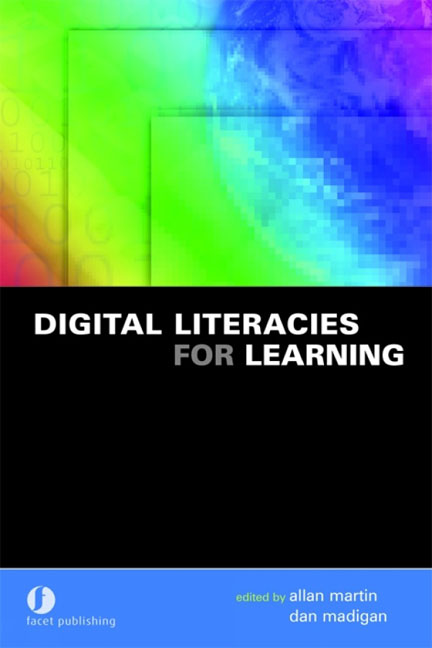Book contents
- Frontmatter
- Contents
- Dedication
- The contributors
- Foreword
- Preface
- Part I Literacies in the digital age
- 1 Literacies for the digital age: preview of Part 1
- 2 Learners, learning literacy and the pedagogy of e-learning
- 3 Real learning in virtual environments
- 4 Digital fusion: defining the intersection of content and communications
- 5 Literacy and the digital knowledge revolution
- 6 Understanding e-literacy
- 7 Information literacy – an overview
- 8 Contemporary literacy – the three Es
- 9 Reconceptualizing media literacy for the digital age
- 10 Literacy, e-literacy and multiliteracies: meeting the challenges of teaching online
- 11 Graduate e-literacies and employability
- Part II Enabling and supporting digital literacies
- Index
8 - Contemporary literacy – the three Es
from Part I - Literacies in the digital age
Published online by Cambridge University Press: 08 June 2018
- Frontmatter
- Contents
- Dedication
- The contributors
- Foreword
- Preface
- Part I Literacies in the digital age
- 1 Literacies for the digital age: preview of Part 1
- 2 Learners, learning literacy and the pedagogy of e-learning
- 3 Real learning in virtual environments
- 4 Digital fusion: defining the intersection of content and communications
- 5 Literacy and the digital knowledge revolution
- 6 Understanding e-literacy
- 7 Information literacy – an overview
- 8 Contemporary literacy – the three Es
- 9 Reconceptualizing media literacy for the digital age
- 10 Literacy, e-literacy and multiliteracies: meeting the challenges of teaching online
- 11 Graduate e-literacies and employability
- Part II Enabling and supporting digital literacies
- Index
Summary
Abstract
Retooling classrooms for 21st-century teaching and learning will not be served by completely reinventing literacy. It is important to acknowledge the continuing value of reading, arithmetic and writing, as basic skills, and to build on that foundation and expanded model of contemporary literacy. This chapter seeks to start with the three Rs, and grow them into three Es, an expanded model for being proficient and efficient users of information.
Introduction
Before we begin a discussion of contemporary literacy, it is important to settle on a definition for ‘literacy’ that can serve as a framework. This is no small task, considering that the word has been used in a wide variety of contexts, addressing a broad range of skill sets. But, for the sake of this chapter, I want to suggest a consensus around the following definition:
Literacy comprises those essential information skills required to accomplish goals within one's contemporary information environment.
The only part of this definition that might seem out of place to most 21st-century inhabitants is the last part, ‘within one's contemporary information environment’. During most of the last two centuries, that environment changed very little. It was at the beginning of the 19th century that Sir William Curtis, Lord Mayor of London, coined the phrase, ‘the three Rs’. Not an extraordinarily literate man, as evidenced by his spelling, Curtis did effectively define an effective literacy framework for a published-print information environment.
Today, however, that environment has changed, and it has happened in just 30 years – mostly in the last ten years. Information has changed in what it looks like, what we look at to view it, where and how we find it, what we can do with it, and how we communicate it.
Any effort to effectively define a new literacy model that reflects this new information environment effectively requires us to drill down into the roots of how information has changed. Factoring all aspects of information reveals three new characteristics of the contemporary information environment that are fundamental to using this environment to accomplish goals: information is networked; information is digital; and information is in abundance.
Information is networked
Information in the published-print environment was networked. But it was a network based on transporting paper and other printed materials across oceans, rivers, mountains, towns and across the classroom.
- Type
- Chapter
- Information
- Digital Literacies for Learning , pp. 89 - 98Publisher: FacetPrint publication year: 2006



